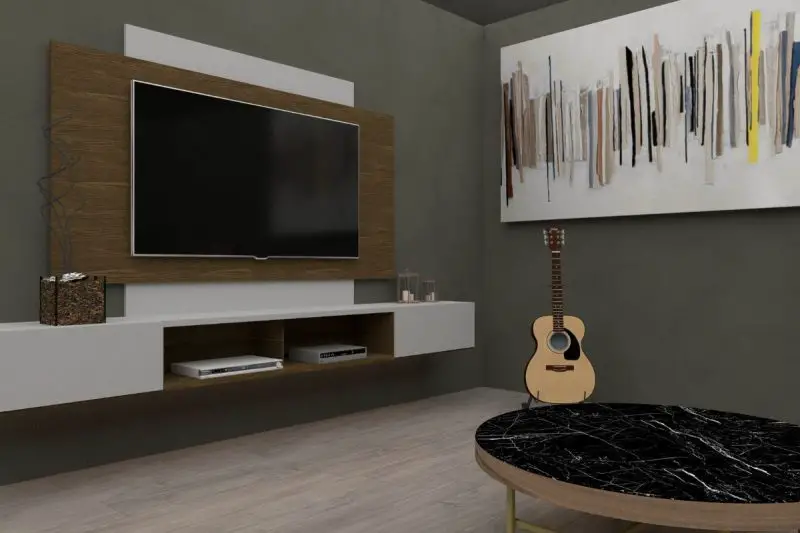55 inch television is a big deal nowadays. People spend thousands of dollars on these TVs. What makes them special?
The size of the screen has become a major factor in choosing a new TV (see also ‘65-Inch TV Dimensions‘).
Most consumers want bigger screens because they believe that larger displays offer better picture quality.
However, some experts say that the benefits of having a large display are overstated.
In reality, the biggest benefit of buying a 55 inch TV is that it allows you to watch movies or play games at home without needing to go out to the movies.
Knowing the exact dimensions of a 55 inch TV can be quite confusing. Manufacturers say that the screen is 55 inches wide, but what does that actually mean?
To find out exactly how big a 55 inch TV really is (see also our article on converting 8 inches), we had to measure it ourselves. We used a ruler and got some measurements.
The measurement of a 55 inch TV (see also our article on converting 3 inches) is called diagonal screen size. This refers to the distance across the middle of the screen, measured horizontally.
Diagonal screen sizes are usually given in centimeters, millimeters, or even pixels. 55 inches (see also ‘How Big Is 12 Inches?’) works out at 121.7cms width by 68.6cm height.
Box Dimensions
The television for transportation is usually packed into polystyrene foam. This prevents damage to the product during transport and provides protection against moisture.
Depending on the manufacturer, the size of the box may differ slightly, but on average the sizes of the packages for transporting a 55-incher are as follows.
Height: 33 inches, 83 cm Length: 55 inches, 140 cm Width: 6 inches, 15 cm
Sitting Distance
When determining the normal sitting distance for your TV, you need to take into account both the size of the screen and the resolution.
You should also consider the environment where you watch TV and the type of programming you are watching at the moment.
According to Sony there is no set rule on how close you should sit from the TV.
However, it recommends that you keep the distance between you and the TV at least three times the height of the screen.
So for a 55 inch TV, that would mean you should sit 83 inches from the TV.
If your TV is smaller, like a 42 inch TV, you could sit closer while if the TV is larger like a 65 inch TV, you should sit farther away.
Will It Fit In A Car ?
When buying a new TV, one concern many people have is figuring out if it will fit into their vehicle.
While TVs are getting bigger each year, there are still limitations. A 55 inch TV will generally fit in most cars.
Even though a 42 inch TV is much better suited for most vehicles, it doesn’t mean it fits perfectly.
There are several factors that determine how well a TV will fit in a vehicle including the type of vehicle, the width of the car and the location of the TV within the vehicle.
The best way to find out if a TV will fit in your vehicle is to measure the dimensions of both the TV and the vehicle.
You can do this yourself or take it to a professional installer.
Once you know what measurements you need, you can use our TV Fit Calculator to see if a particular TV will fit.
Features
The market for big screen televisions continues to grow, and consumers are looking for the best technology possible.
This includes features like HDR, Dolby Vision, and 4K Ultra HD. There are many different options for 55 inch TVs, including LED, OLED, LCD, plasma, and even DLP projectors. But what do you really need on a big screen?
Here are some things to consider when choosing a 55 inch TV.
HDR – High Dynamic Range
This feature allows for much greater contrast ratios than standard displays. It provides richer colors and deeper blacks.
With HDR, images are displayed as though there are no shadows or highlights. They are brighter and darker without distortion.
4K Resolution
With 4K resolution, you can see four times the detail of 1080p screens. You’ll notice things like finer lines and textures, sharper text, and clearer photos.
If you want the best picture quality, it makes sense to invest in a 4K TV.
Full Array Local Dimming
Local dimming adjusts the brightness of individual pixels across the entire display. It helps reduce motion blur and produce smoother pictures.
Full array local dimming works well with HDR because it ensures that every pixel gets the same amount of light.
HDR
Full array LED technology has been around since 2013. But HDR (high dynamic range) is just now becoming mainstream. In fact, it’s still considered a niche feature.
However, HDR is quickly gaining popularity because it offers a wider range of colors and improved contrast compared to standard televisions.
The benefits of HDR include better overall picture quality, brighter whites, deeper black levels, and greater detail.
This is especially important for movies and games where you want to see every single pixel clearly.
The biggest benefit of HDR is the ability to display a wider range of colors. You don’t have to worry about having a limited palette anymore.
HDR lets you enjoy a much richer visual experience.
Another key advantage of HDR is that it allows for higher contrast ratios. This makes the image easier to view, even outdoors.
And finally, HDR delivers better contrast. It helps make images pop out against the background.
So, there’s no longer a dull gray area behind bright objects like people or cars. Instead, everything pops off the screen.

Smart TVs
As technology continues to improve, many people are turning toward smart TVs. These devices combine Internet connectivity with traditional features such as high definition displays and surround sound speakers.
Smart TVs offer lots of convenience, including the ability to stream movies, play games and control home appliances like lights and thermostats.
However, there are some drawbacks to owning one, too. For example, most smart TVs require additional hardware to connect to the Internet.
And while you could use a separate device to stream video over Wi-Fi, doing so requires extra steps.
If you don’t already have a set-top box, you’ll likely end up spending money on another piece of equipment just to enjoy the benefits of a smart TV.
Smart TVs often come with built-in apps that make watching videos easy.
You can also buy third-party apps separately, allowing you to customize your experience further.
In fact, some smart TVs include voice assistants like Alexa and Siri, making it easy to interact with the device via spoken commands.
Is 55 Inches Big Enough ?
First things first, there are three key factors to consider when choosing the best size TV for your home: screen size, space, and proximity.
Screen Size
A 55 inch TV is large enough to fill up most living rooms. However, if you’re looking for something bigger, you might want to look into a 65 inch TV.
A 65 inch TV provides a much better experience than a 55 inch TV. Not only because it’s more immersive but also because it requires less bending and stretching.
Space
If you live in a small apartment, you’ll probably struggle to fit a 55 inch TV in your living room. Ideally, you’d like to place your TV somewhere between the couch and the bedroom.
The closer it is to the couch, the bigger the TV will feel.
TV Placement
Knowing the dimensions of your television isn’t just important for the sake of aesthetics; it’s also essential when it comes to getting the most out of your home theater setup.
If you’re planning on watching movies or playing games (see also ‘Funko Pop Box Dimensions‘), there are certain distances that work better than others.
For example, you’ll notice that the image quality degrades noticeably when you place a large TV up against a wall.
The same goes for placement within your living room. TVs that are too far away from the center of the room tend to look distorted or blurry.
However, if you position your TV too close to the edge of the room, you run the risk of having some parts of the screen bumped into or worse, broken!
As mentioned earlier, the distance from the television to the wall is important because it affects the quality of the image.
A larger screen requires you to sit farther away from it, which makes it harder to view without distorting the picture.
You should also consider the size and shape of the room. If there are walls surrounding the area, you’ll have less flexibility in terms of placement.
The next thing to keep in mind is the size of the space itself. If you’re setting up a large flat-screen TV in a small living room, you’ll probably find yourself sitting closer to the screen than you would in a bigger space.
In Summary
If you want to watch movies in 4K quality, you’ll probably need a TV with a screen diagonal of 55 inches or larger.
The reason why it’s recommended to buy a bigger TV is because smaller screens just don’t offer enough pixels to display high-quality images.
With a 55-inch TV, you’ll see crisp, clear pictures without having to turn up the brightness too much.
55 inches is a good size TV for the living room, but if you have a small living room space then it may be too big.
If you are looking to get a 55-inch TV, make sure that your budget allows for this purchase.
The price of these TVs can range from $1,000 to over $10,000 depending on the model and brand.
- What Size is Regular Printer Paper? Quick Guide for Paper Dimensions - June 18, 2023
- What Size is My Monitor: A Comprehensive Guide - June 18, 2023
- How Big is Italy Compared to the US? A Concise Comparison - June 16, 2023

